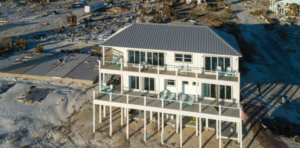Five years ago today, Hurricane Michael, a Category 4 storm, made landfall on the small Florida town of Mexico Beach. The storm left behind a trail of destruction, so much so that FEMA said the area was “wiped out” and designated it “ground zero.”
One home, dubbed the “Sand Palace of Mexico Beach,” was designed to withstand winds of 250 miles per hour, nearly double the requirement for the area, and nearly 100 mph above the recorded wind speeds from Hurricane Michael. The home was one of the only structures left standing after the storm had cleared, with only minimal damage sustained.

The homeowners made a conscience decision to build a home that could withstand even the strongest hurricanes that could impact the area. One of the main features in the construction of the home was the use of spray foam insulation in the overall design and build. For example, the closed-cell foam helped the roof endure the blunt force of the winds during the storm, keeping it intact. As one of the homeowners said, “I think spray foam did a great job of not only insulating our home, but also unifying and solidifying the roof!”
Spray foam insulation also helped increase the overall resiliency and strength of the structure, from the ground floor up.
To incentivize homeowners to improve their homes’ resiliency, Florida lawmakers passed H.B. 799 earlier this year, which requires insurance companies to provide premium reductions for homes with wind uplift prevention solutions. This law will go a long way to help prevent the roof of a home from being lost in the face of a natural disaster.
Homeowners, particularly those in hurricane-vulnerable areas, looking to strengthen the overall structure of their home, ensure overall comfort, and reduce their utility costs, should look to spray foam insulation as a vital building material to help your home weather the storm.